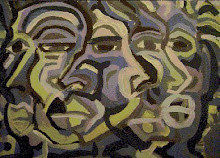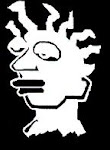 The Sierpinski Triangle is a basic example of a geometric fractal.
The Sierpinski Triangle is a basic example of a geometric fractal. But triangles often seem to be used to represent something that has an ethereal or esoteric value.
But triangles often seem to be used to represent something that has an ethereal or esoteric value.Even Dali used the triangle (The points of the hands and feet of Christ in the above image form a triangle representing; Father, Son and Holy Spirit.).

Keith Herring uses the triangle as a center point between two UFOs.
 The Pineal eye of the American dollar bill.
The Pineal eye of the American dollar bill.


Keith Herring uses the triangle as a center point between two UFOs.
 The Pineal eye of the American dollar bill.
The Pineal eye of the American dollar bill.
The pyramids.

The double triangle of the Star of David.

The double triangle of the Star of David.
But the addition of the inverted triangle to the Eye of G-D triangle (above) would suggest a different meaning - kind of like the Elegba (both and neither bad (n)or good) reference of SeeNew to an earlier post.














7 comments:
Environmental Design Scienctist, Buckminster Fuller, said that the triangle was the world's most perfect structure. He built his Biosphere and other creations from triangular shaped sections, based on the concept that the more pressure you put on a triangle, the stronger it becomes. He even pointed to human skin being constructed in triangular sections.
I don't know if this adds to your conversation, but it's the first time I've had a chance to use any part of my grad school education in a blog response.
@ Dwayne T - This is baby stuff... check out Craig an dem at Subrealism --->
John,
Here's a little something I wrote some years ago relating to/contextualizing this subject - as I understand it.
I am of course only dipping my toe beneath the surface.
If you wish to dive, I heartily recommend de Lubicz as a fruitful entry point.
Painfully challenging material presented ergodically - which must be read, re-read, and re-read yet again - in order to fathom its gist.
@ cnulan - Dude, I had to order that Jaynes book. Seems that the topic was too much for my local Barnes and Noble.
I PROMISE it will rock your world John. Please let me know what you think after you've read it.
The two chapters in which Jaynes deconstructs consciousness are absolutely devastating.
It doesn't take any of the magic out of the world, mind you - it just forces you to come to grips with some aspects of introspective experience that may not otherwise ever get interrogated.
For me personally, it made me think twice about what I'd always been taught about being "saved by grace" - that effortless stuff that gets peddled in every church on every corner and in ever storefront in America - and to examine the lives of the saints which speak unanimously and exclusively about the incredible difficulties involved with glorification via work and struggle.
Jaynes gave me a rigorous ground for understanding just how insubstantial our ordinary waking state of consciousness is, and greater appreciation for moments of peak consciousness and what these represent relative to the ordinary waking state.
Finally, the esoteric systematizations of the world, such as what you've pointed toward in this post, become far more deeply meaningful in the light of their representation of a semi-continuous stream of higher and more permanent consciousness that is embodied and communicated nearly exclusively in this mysterious "language of form".
Check out this joint here. It'll make a lot more sense on a bellyfull of Jaynes, but you may find it provocative in its own right, as well.
Generic apcalis sx oral jelly orange flavor World delivery hytrin Online prograf Discount cialis super active 50mg betagan ED phenergan
Post a Comment